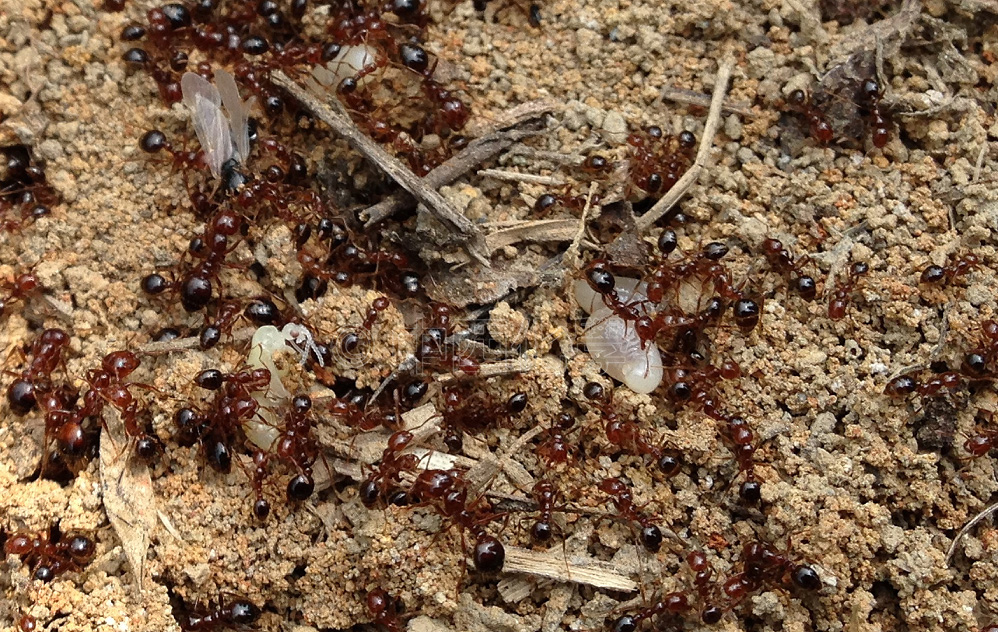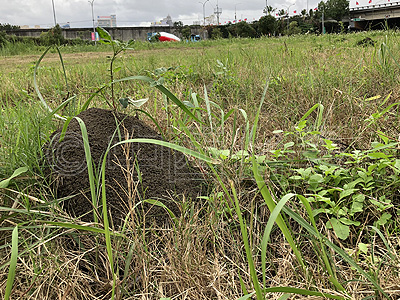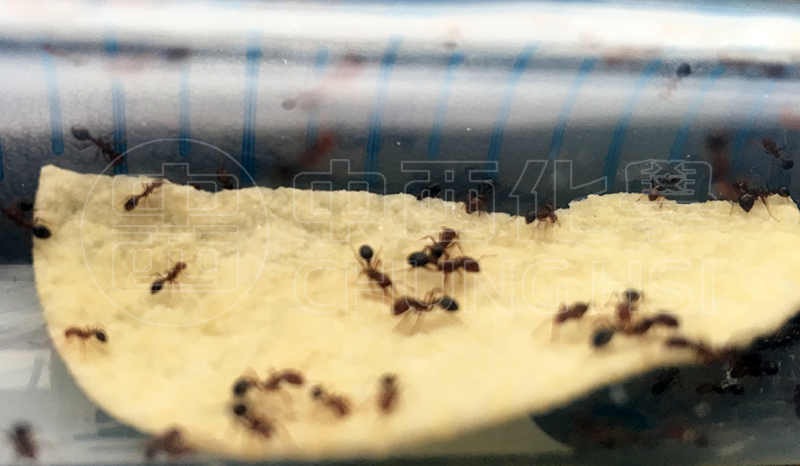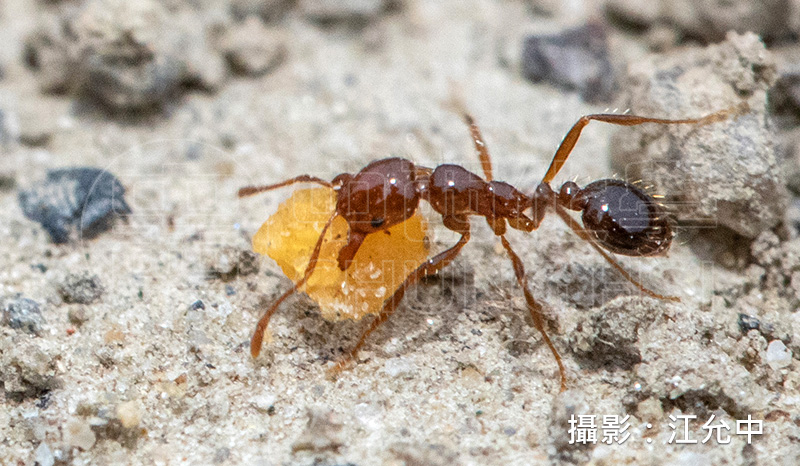BACK
2023 / 12 / 25

The red imported fire ant (Solenopsis invicta) was one of the most concerned pests among the invasive species that invaded Taiwan in recent years. Both the government and general public have invested considerable manpower, resources and money in its management, but it has been affected by factors such as the inaccessibility of fenced-in private land, the difficulty of manual treatment on hillside and riverbanks, or the poor weather conditions, which is not suitable to apply pesticides. There has been no way to completely exterminate the imported red fire ants in Taiwan, all we can only try to suppress them in the original infestation area.
There are nearly 300 species of ants in Taiwan. When many people see reddish-brown color ants, they worry whether they are the fire ants in the news. Red imported fire ants can be distinguished from other species of ants by a number of characteristics.
(Picture: Fire ant workers move with their pupae and larvae, the black ones with wings are the males)
There are nearly 300 species of ants in Taiwan. When many people see reddish-brown color ants, they worry whether they are the fire ants in the news. Red imported fire ants can be distinguished from other species of ants by a number of characteristics.
(Picture: Fire ant workers move with their pupae and larvae, the black ones with wings are the males)

1. There are raised and dense ant mounds with a porous structure inside.
S. invicta workers like to build their mound on land that has sufficient sunshine and has been disturbed by humans. Therefore, artificially prepared environments such as farmland, nurseries, lawns, safety islands, and sidewalks are common places where fire ant mounds appear. Workers will dig nests in the soil and pile the excavated soil on the surface. At first, there will be irregular, loose and low mounds of soil on the ground. However, because many species of ant live underground, they can also cause some soil piles, so it is easy to confuse rifa with other species of ants at this time. After a period of time, the nest turns into a raised mound with a somewhat loose surface. If there is no heavy rain or external damage, after about 1 to 3 months, a dense raised mound with no visible openings will be formed. Usually the size of the mound is approximately the size of the ant nest beneath the ground. If you dig up the nest, you can see that there are porous and even structure inside, the holes are average in size and closely arranged.
2. Very aggressive behavior and severe pain when stung
The radius of about 1 meter around red imported fire ant mound is already their warning range. When someone steps into the area, the workers will start to commotion. If the mound is minor destroyed, the fire ants will come out to defend their home. When fire ants crawl onto exposed skin, they will first bite the skin with their mandibles (mouth part), and then sting the victim, just like a hornet. The person being attacked will feel as painful as being burned by fire. The stung point may become red, swollen or even blistered, and some people may be allergic to fire ant venom. In severe cases, it may cause shock and some people get killed.
Generally speaking, ants living in areas with human activities don't have huge raised mounds, and there are few species that react violently when encountering harassment, and most of them usually flee in a hurry. Based on the above characteristics of ant mound and behaviors, it is not difficult to identify red imported fire ants.
S. invicta workers like to build their mound on land that has sufficient sunshine and has been disturbed by humans. Therefore, artificially prepared environments such as farmland, nurseries, lawns, safety islands, and sidewalks are common places where fire ant mounds appear. Workers will dig nests in the soil and pile the excavated soil on the surface. At first, there will be irregular, loose and low mounds of soil on the ground. However, because many species of ant live underground, they can also cause some soil piles, so it is easy to confuse rifa with other species of ants at this time. After a period of time, the nest turns into a raised mound with a somewhat loose surface. If there is no heavy rain or external damage, after about 1 to 3 months, a dense raised mound with no visible openings will be formed. Usually the size of the mound is approximately the size of the ant nest beneath the ground. If you dig up the nest, you can see that there are porous and even structure inside, the holes are average in size and closely arranged.
2. Very aggressive behavior and severe pain when stung
The radius of about 1 meter around red imported fire ant mound is already their warning range. When someone steps into the area, the workers will start to commotion. If the mound is minor destroyed, the fire ants will come out to defend their home. When fire ants crawl onto exposed skin, they will first bite the skin with their mandibles (mouth part), and then sting the victim, just like a hornet. The person being attacked will feel as painful as being burned by fire. The stung point may become red, swollen or even blistered, and some people may be allergic to fire ant venom. In severe cases, it may cause shock and some people get killed.
Generally speaking, ants living in areas with human activities don't have huge raised mounds, and there are few species that react violently when encountering harassment, and most of them usually flee in a hurry. Based on the above characteristics of ant mound and behaviors, it is not difficult to identify red imported fire ants.
Native fire ants such as the tropical fire ant (Solenopsis germinata)
When many Taiwanese hear "biting red ants", they will question: "Didn't red ants with painful bites (stings) exist a long time ago?" In fact, studies showed that the US military stationed in Taiwan decades ago accidentally let a kind of ants of the genus Solenopsis invaded Taiwan and became a naturalized species. They are now widely distributed in central, southern and eastern Taiwan. These are "tropical fire ants". There are only sporadic cases of tropical fire ants in northern Taiwan. According to the scientific studies, the average annual temperature in central and southern Taiwan is more stable, which is more suitable for tropical fire ants with lower low-temperature tolerance. Perhaps it is also for this reason that red imported fire ants are domain in the northern Taiwan because lacking strong local competitive ant species with similar niche.
Tropical fire ants are slightly less aggressive than red imported fire ants, but their stings can also cause swelling and pain (people who have been stung by both species report that the sting of tropical fire ants is more painful). Both fire ants live underground and have similar niche, but they can be distinguished in the following ways:
When many Taiwanese hear "biting red ants", they will question: "Didn't red ants with painful bites (stings) exist a long time ago?" In fact, studies showed that the US military stationed in Taiwan decades ago accidentally let a kind of ants of the genus Solenopsis invaded Taiwan and became a naturalized species. They are now widely distributed in central, southern and eastern Taiwan. These are "tropical fire ants". There are only sporadic cases of tropical fire ants in northern Taiwan. According to the scientific studies, the average annual temperature in central and southern Taiwan is more stable, which is more suitable for tropical fire ants with lower low-temperature tolerance. Perhaps it is also for this reason that red imported fire ants are domain in the northern Taiwan because lacking strong local competitive ant species with similar niche.
Tropical fire ants are slightly less aggressive than red imported fire ants, but their stings can also cause swelling and pain (people who have been stung by both species report that the sting of tropical fire ants is more painful). Both fire ants live underground and have similar niche, but they can be distinguished in the following ways:
1. Tropical fire ants do not build bulging and dense mounds, and the holes inside vary in size.
2. The major workers of tropical fire ants have a relatively large head-to-body ratio, which is not as average as that of red imported fire ants.
3. If the workers of the two species can be compared together, the body color of tropical fire ants is lighter, leaning toward orange-red; while the body color of red imported fire ants is darker, leaning toward reddish brown to dark red.
As for the characteristics described in common promotional materials, such as the anterior margin of the clypeus has a single median tooth on the midline, and the number of antennae segments, etc., this method is feasible for institutions or research units with microscopes, but it is very difficult for the general public, so it can be done in the above way. Quick identification is relatively simple. For the differences in appearance between tropical fire ants and red imported fire ants, please refer to the photos on the National Fire Ant Control Center's webpage.
In addition, there are two native fire ants in Taiwan: S. indagatrix and S.tipuna. These two ant species are small in size and have a limited distribution range. They are rarely related to human, so there is no need to be too concerned. Many people think that the biting fire ants in eastern Taiwan are these two fire ant species, but they are actually tropical fire ants. Recently, another ant that stings, the internationally renowned invasive species Wasmannia auropunctata (electric ant) has been confirmed to have invaded central Taiwan in 2021, which is worth noting.
2. The major workers of tropical fire ants have a relatively large head-to-body ratio, which is not as average as that of red imported fire ants.
3. If the workers of the two species can be compared together, the body color of tropical fire ants is lighter, leaning toward orange-red; while the body color of red imported fire ants is darker, leaning toward reddish brown to dark red.
As for the characteristics described in common promotional materials, such as the anterior margin of the clypeus has a single median tooth on the midline, and the number of antennae segments, etc., this method is feasible for institutions or research units with microscopes, but it is very difficult for the general public, so it can be done in the above way. Quick identification is relatively simple. For the differences in appearance between tropical fire ants and red imported fire ants, please refer to the photos on the National Fire Ant Control Center's webpage.
In addition, there are two native fire ants in Taiwan: S. indagatrix and S.tipuna. These two ant species are small in size and have a limited distribution range. They are rarely related to human, so there is no need to be too concerned. Many people think that the biting fire ants in eastern Taiwan are these two fire ant species, but they are actually tropical fire ants. Recently, another ant that stings, the internationally renowned invasive species Wasmannia auropunctata (electric ant) has been confirmed to have invaded central Taiwan in 2021, which is worth noting.
Fire ant control
To inspect the presence of fire ants:
In addition to the aforementioned ant mound features that can be used to identify fire ants, once fire ant activity is suspected, you can place a commercially available potato chip (such as Pringles original) on the ground nearby (it is recommended to place a warning sign or shielding device at the same time), and check again after about 30 minutes. Fire ants like food rich in oil, and you should see many workers gathering on the potato chips. However, some ants that are not fire ants may also be attracted to potato chips, so it is best to find other evidence, such as ant mound, to strengthen the confirmation. Subsequent fire ant control will vary depending on the level of infestation.
To inspect the presence of fire ants:
In addition to the aforementioned ant mound features that can be used to identify fire ants, once fire ant activity is suspected, you can place a commercially available potato chip (such as Pringles original) on the ground nearby (it is recommended to place a warning sign or shielding device at the same time), and check again after about 30 minutes. Fire ants like food rich in oil, and you should see many workers gathering on the potato chips. However, some ants that are not fire ants may also be attracted to potato chips, so it is best to find other evidence, such as ant mound, to strengthen the confirmation. Subsequent fire ant control will vary depending on the level of infestation.


Left: Using potato chip in plastic tubes to inspect red imported fire ants / Right: Foraging worker hold a particle of Chung Hsi’s hydrophobic bait in their mouths to take back to the nest
Bait:
Bait control is suitable for both large and small areas. Fire ant bait is in granular form and should be spread evenly around the ant mound according to the instructions on label. Once the workers find the bait when they go out to forage, they will carry it back to the nest and feed it to the larvae. Workers cannot swallow solid food directly, so they will wait for the larvae to digest it before asking for liquid food from the larvae, which they will later share with other adult fire ants, this is called “trophallaxis” behavior. Because the insecticidal active ingredients in baits rely on their feeding and dispersion, the active ingredients are not highly toxic and will not kill workers quickly, or the insect growth regulators (IGR) only act to disrupt the growth of larvae, and reduce their queen's reproductivity. There are two hydrophobic baits developed by Chung Hsi Chemical through industry-academic collaboration in Taiwan: Erasant®-IGR and Erasant®-toxicant, which are based on the biological characteristics of fire ants and Taiwan's humid and rainy weather. These baits are recommended by governemnt, many pest control companies and 3rd party research institutes in Taiwan.
Bait will take some time to reveal its effect. Many people often cannot wait and disturb the fire ant mounds, which is counterproductive. So can we take pesticides and pour them directly into the ant nest? In most cases, this will only kill a small number of fire ants. Instead, it will disturb the fire ants and cause them to flee with their families. After a period of time, more ant mounds will gradually rise, at which point the fire ant problem became worse.
Bait:
Bait control is suitable for both large and small areas. Fire ant bait is in granular form and should be spread evenly around the ant mound according to the instructions on label. Once the workers find the bait when they go out to forage, they will carry it back to the nest and feed it to the larvae. Workers cannot swallow solid food directly, so they will wait for the larvae to digest it before asking for liquid food from the larvae, which they will later share with other adult fire ants, this is called “trophallaxis” behavior. Because the insecticidal active ingredients in baits rely on their feeding and dispersion, the active ingredients are not highly toxic and will not kill workers quickly, or the insect growth regulators (IGR) only act to disrupt the growth of larvae, and reduce their queen's reproductivity. There are two hydrophobic baits developed by Chung Hsi Chemical through industry-academic collaboration in Taiwan: Erasant®-IGR and Erasant®-toxicant, which are based on the biological characteristics of fire ants and Taiwan's humid and rainy weather. These baits are recommended by governemnt, many pest control companies and 3rd party research institutes in Taiwan.
Bait will take some time to reveal its effect. Many people often cannot wait and disturb the fire ant mounds, which is counterproductive. So can we take pesticides and pour them directly into the ant nest? In most cases, this will only kill a small number of fire ants. Instead, it will disturb the fire ants and cause them to flee with their families. After a period of time, more ant mounds will gradually rise, at which point the fire ant problem became worse.

